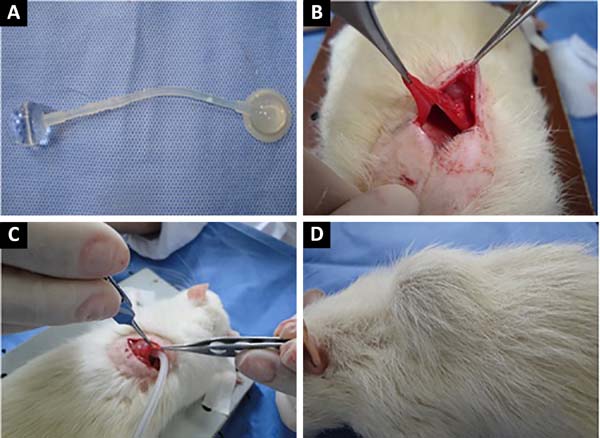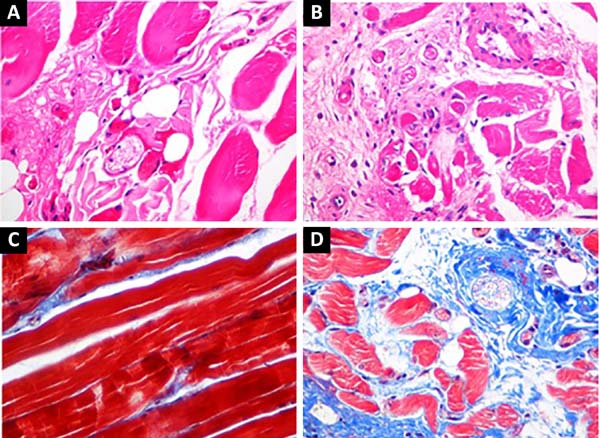INTRODUCTION
Tissue expansion is widely used in plastic surgery and relies on the
biomechanical properties of tissues submitted to progressive tension1.
Natural expansion with rapid adaptation occurs during physical growth, as in the
enlargement of breasts at puberty and during gestation2.
The expansion process can be used in larger lesions or in areas with limited
distensibility, allowing repair of large tissue losses of congenital origin or
those caused by trauma or tumors3-5.
A major problem in progressive muscle expansion is pain, probably secondary to
muscle spasm induced by hypoxia. Attenuation or absence of pain in elective or
traumatic surgical denervation of a particular muscle that will be expanded is
observed, for example, in breast reconstruction with use of an expandable
prothesis6,7. In addition, pain is reduced after
relaxation with botulinum toxin in the expanded muscle used for breast
reconstruction with a prosthesis7,8.
Expansion leads to a gain in muscle compliance, contributing to decreased tension
in the sutures. The histological changes include muscular hypertrophy, change in
fiber shape and nuclear position, and an increase and changes in blood vessels.
These changes are not seen in acute muscle expansion performed intraoperatively
because a longer time is needed to stimulate permanent muscle growth4.
OBJECTIVES
This study describes the histological changes in the latissimus dorsi muscle
submitted to expansion after relaxation with botulinum toxin. Potential
practical benefits include increased muscle compliance, better accommodation of
a prosthesis, and reduction of pain.
METHODS
This is the pilot study for a research project approved by the Ethics Committee
on the Institutional Use of Animals. Ten Wistar rats (Rattus
norvegicus) with a mean weight of 300 g and age about 6 months were
used. The muscle used for expansion was the latissimus dorsi because it was easy
to approach and thin, with a visible cleavage plane and underlying bone.
Human orbit expanders with diameter of 1.7 cm and volume of 3 ml were used. The
expanders were smooth, with two valves, and were sterilized with ethylene oxide.
The expanders were registered at the National Agency of Sanitary Surveillance
(Figure 1-A).
Figure 1 -
A: Human orbit expander developed for this study;
B: Incision used to insert the expander into the
latissimus dorsi muscle; C: Expander insertion;
D: Appearance after expansion.
Figure 1 -
A: Human orbit expander developed for this study;
B: Incision used to insert the expander into the
latissimus dorsi muscle; C: Expander insertion;
D: Appearance after expansion.
Botulinum toxin type A was used in lyophilized form. A 100 IU vial was diluted
with 4 ml of 0.9% physiological solution to obtain 25 IU/ml at a dose of 1
IU/cm2 of muscle. Infiltration was performed with 1 ml syringes
and insulin needles and two reference traces of the syringe infiltrated.
Five animals were submitted to expansion of the latissimus dorsi without
botulinum toxin and 5 received prior botulinum toxin.
After incision and identification of the latissimus dorsi, submuscular blunt
dissection was performed to create a space for the expander (Figure 1-B). The valve connected to the
expander was positioned in subcutaneous tissue to facilitate identification for
future puncture. Muscle samples were collected for histological evaluation
before and at the end of the expansion. Ten expansions were made, at intervals
of 7 days, using 0.3 ml for each treatment.
To insert the expander, the animals were anesthetized with 2% xylazine
hydrochloride at a dose of 5 mg/kg, at a concentration of 9.1 mg/ml (weight ×
dose × 1/concentration), combined with ketamine at a dose of 50 mg/kg,
intraperitoneal (Figure 1-C).
Immediately after positioning of the expander, 10% of its capacity was filled
with methylene blue dye saline to monitor possible extravasation. After complete
expansion (Figure 1-D), muscle samples were
collected for histological analysis and immediately fixed in 4% buffered
formalin. The samples were processed, embedded in paraffin, and 4-μm slices were
prepared with a microtome. Histological sections were stained with
hematoxylin-eosin (HE) for general evaluation, and Masson’s trichrome (TM) for
evaluation of connective tissue.
The slides were simultaneously examined under a standard light microscope by 2
observers. The presence of muscle atrophy, change in the position and size of
the muscle cell nucleus, presence of inflammation, change in the number of blood
vessels, and the presence of deposits were evaluated in the samples stained with
HE.
The findings were compared in the pre-expansion groups with and without prior
relaxation with botulinum toxin. In the samples stained with TM, the amount of
blue-stained connective tissue between the red-stained muscle fibers was
evaluated.
RESULTS
Muscle fibers biopsied prior to expansion in animals from the groups with and
without botulinum toxin relaxation were considered normal muscle and used as
controls.
Animals submitted to expansion without botulinum toxin showed foci of fibrosis,
with an increase in connective tissue between the muscle fibers and between the
muscle fascicles. The changes were more intense than in the group that underwent
relaxation with botulinum toxin.
In addition, there was a greater increase in the number of blood vessels,
skeletal muscle atrophy, and centralization of nuclei, as well as less muscle.
The group without botulinum toxin also exhibited foci of old hemorrhage and mild
nonspecific inflammatory infiltrates with lymphocytes and plasma cells; these
were not seen in the botulinum toxin group (Figure 2).
Figure 2 -
A: Skeletal muscle before expansion (HE, 400×);
B: Skeletal muscle after expansion and application
of botulinum toxin (HE, 400×); C: Sparse connective
tissue (blue) between muscle fibers (red) in skeletal muscle before
expansion (TM, 400×); D: Increased connective tissue
(blue) between muscle fibers (red) after expansion and application
of botulinum toxin (TM, 400×).
Figure 2 -
A: Skeletal muscle before expansion (HE, 400×);
B: Skeletal muscle after expansion and application
of botulinum toxin (HE, 400×); C: Sparse connective
tissue (blue) between muscle fibers (red) in skeletal muscle before
expansion (TM, 400×); D: Increased connective tissue
(blue) between muscle fibers (red) after expansion and application
of botulinum toxin (TM, 400×).
DISCUSSION
It is believed that the increased fibrosis in animals submitted to skeletal
muscle expansion probably results from tissue ischemia caused by expansion and
consequent distension and compression of blood vessels. Cytokines would be
released and would induce vascular proliferation9.
When the botulinum toxin group was evaluated, fibrosis and vascular proliferation
were less intense. Relaxation in the toxin-treated musculature probably
decreased the local ischemia8,10-12, explaining
the differences. In addition, less atrophy was found, as no inflammation was
found, possibly due to decreased release of proinflammatory cytokines9. Easier expansion after muscle relaxation
would explain the absence of bleeding in this group6,7.
A major problem in progressive tissue expansion is the pain that can lead to
interruption of treatment8,13. Studies have
demonstrated reduced pain in expanded muscle used in breast reconstruction,
following prosthesis insertion with botulinum toxin pretreatment8,9,13.
In addition to muscle relaxation, it is believed that the decreased hypoxia in
muscle fibers is associated with reduction of pain, perhaps due to a decrease in
the release of pain-inducing substances6,13.
CONCLUSIONS
Botulinum is relatively safe and easy to use. Botulinum-induced muscle relaxation
results in less abrupt and painful muscle stretching.
Because of the small size of the sample, further studies are needed. However,
these findings agree with literature data, allowing us to assume that use of
botulinum toxin-treated expanded skeletal muscle, in addition to reducing pain,
allows greater relaxation and preservation of muscle tissue, with added
distensibility and better accommodation of a prosthesis.
COLLABORATIONS
|
MPSN
|
Conception and design of the study; completion of surgeries and/or
experiments.
|
|
LCR
|
Conception and design of the study; completion of surgeries and/or
experiments.
|
|
ECSA
|
Analysis and/or interpretation of data; final approval of the
manuscript; writing the manuscript or critical review of its
contents.
|
|
ACRD
|
Completion of surgeries and/or experiments; writing the manuscript or
critical review of its contents.
|
|
ACPB
|
Analysis and/or interpretation of data; completion of surgeries
and/or experiments; writing the manuscript or critical review of its
contents.
|
|
RME
|
Analysis and/or interpretation of data; final approval of the
manuscript; conception and design of the study; completion of
surgeries and/or experiments; writing the manuscript or critical
review of its contents.
|
REFERENCES
1. Argenta LC, Marks MW. Principles of tissues expansion. In: Mathes
SJ, ed. Plastic surgery: general principles. Philadelphia: Saunders Elsevier;
2006. p. 539-67.
2. Neumanm CG. The expansion of an area of skin by progressive
distention of a subcutaneous balloon: use of the method for securing skin for
subtotal reconstruction of the ear. Plast Reconstr Surg (1946).
1957;19(2):124-30. DOI: http://dx.doi.org/10.1097/00006534-195702000-00004
3. Chun JT, Rohrich RJ. Versatility of tissue expansion in head and
neck burn reconstruction. Ann Plast Surg. 1998;41(1):11-6. PMID: 9678462 DOI:
http://dx.doi.org/10.1097/00000637-199807000-00003
4. De Filippo RE, Atala A. Stretch and growth: the molecular and
physiologic influences of tissue expansion. Plast Reconstr Surg.
2002;109(7):2450-62. DOI: http://dx.doi.org/10.1097/00006534-200206000-00043
5. Gemperli R, Brechtbühl ER. Expansores teciduais. In: Mélega JM, ed.
Cirurgia plástica: fundamentos e arte: princípios gerais. Rio de Janeiro: Medsi;
2002. p. 177-83.
6. Layeeque R, Hochberg J, Tillman R, Westbrook K, Yuen JC, Kunkel KM,
et al. Botulinum toxin infiltration for pain control after mastectomy and
subpectoral tissue expansion. Ann Surg 2004;240(4):608-14.
7. Lu L, Atchabahian A, Mackinnon SE, Hunter DA. Nerve injection injury
with botulinum toxin. Plast Reconstr Surg. 1998;101(7):1875-80. PMID: 9623830
DOI: http://dx.doi.org/10.1097/00006534-199806000-00015
8. LoGiudice J, Gosain AK. Pediatric tissue expansion: indications and
complications. J Craniofac Surg. 2003;14(6):866-72. DOI: http://dx.doi.org/10.1097/00001665-200311000-00008
9. Mitchell RN, Kumar V, Abbas AK. Fundamentos de Patologia: Robbins e
Cotran. 8a ed. Rio de Janeiro: Elsevier; 2012.
10. Mathes SJ. Plastic Surgery: general principles. Philadelphia:
Saunders Elsevier; 2006.
11. Pitanguy I. Utilização de expansores cutâneos nas sequelas de
queimaduras. Bol Acad Nac Med. 1991;151(6/9):29-38.
12. Gur E, Hanna W, Andrighetti L, Semple JL. Light and electron
microscopic evaluation of the pectoralis major muscle following tissue expansion
for breast reconstruction. Plast Reconstr Surg. 1998;102(4):1046-51. PMID:
9734422 DOI: http://dx.doi.org/10.1097/00006534-199809020-00019
13. Jankovic J, Brin MF. Therapeutic uses of botulinum toxin. N Engl J
Med. 1991;324(17):1186-94. PMID: 2011163 DOI: http://dx.doi.org/10.1056/NEJM199104253241707
1. Universidade Federal do Triângulo Mineiro,
Uberaba, MG, Brazil.
Corresponding author: Renata Margarida
Etchebehere, Avenida Getúlio Guaritá, 130 - Uberaba, MG, Brazil. Zip
Code 38025-440. E-mail: renataetch@hotmail.com
Article received: September 28, 2017.
Article accepted: September 5, 2018.
Conflicts of interest: none.











